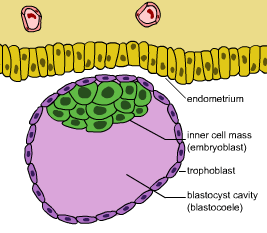Births are little miracles. A new life has been brought into the world. Although most parents view their newborns as special, Emma Gibson is truly a special baby having been conceived in 1992, but born in 2017. Yes, you read that correctly! Emma is truly a miracle with her successful birth being the result of the longest known frozen embryo (24 years).
Emma, along with thousands of babies each year, was born through a process called In Vitro Fertilization. Commonly referred to as IVF, In Vitro Fertilization is an assisted reproductive technique (figure 1). IVF is a fertilization technique that involves ovarian stimulation, extraction of the egg, sperm sample retrieval, and fertilization of the egg and sperm in a laboratory dish. Ovarian stimulation uses hormones to increase the growth of multiple follicles, in order to retrieve a large number of oocytes and to increase the chance of fertilization. The process of embryo transfer, where the embryos that are fertilized in the lab are transferred to a women’s uterus, is the final step of IVF. As new technological advances are being developed to freeze embryos, countless studies are being conducted to determine the difference between using fresh or frozen embryos. Although a study has found there to be no significant difference in live births using the two procedures, there are benefits and drawbacks to certain subsets of the population.

Figure 1. The process of In vitro fertilization where the egg is fertilized by the sperm outside of the womb. Image Credits: MartaFF (author). Wikimedia Commons. Creative Commons Attribution-Share Alike 4.0 International license.
Fresh embryo transfer has certain positive and negative implications associated with it. Often the fresh embryo will be transferred into the uterus 5 to 6 days after successful fertilization. The embryo is able to reach the blastocyst stage (figure 2) prior to transfer. The benefit of fresh embryo transfer includes a shorter overall wait time until pregnancy, as the embryo is transferred soon after the IVF egg retrieval stage. However, there are also several negative implications of fresh embryo transfer. The ovarian stimulation step could result in a higher level of fertility hormones in the system during the time of embryo transfer. A study has found that this process may make it more difficult for the embryo to implant into the uterine lining. In addition, another study has determined that high estrogen levels following ovarian stimulation may result in decreased receptivity of the uterine lining, making it increasingly difficult for the embryo to attach.

Figure 2. The blastocyst stage of an embryo that is to be transferred into the uterus for fresh embryo transfer. Image Credits: Wikimedia Commons. Creative Commons Attribution-Share Alike 3.0 Unported license.
Frozen embryo transfer is another viable option that is being increasingly used by infertile couples, as improvements in technology prevent damage to the embryo from freezing. With this process, the endometrial lining is more ideal for the embryo to implant because the hormones are able to return to a normal level after ovarian stimulation. In addition, a study has determined that babies born from frozen embryos may weigh more than those born from fresh embryos. The researchers believe the higher fetal growth and mean birth weight may be due to certain epigenetic changes in early embryonic stages, as a result of the freezing and thawing procedures. In addition, frozen embryo transfer has been recently determined to result in a higher overall implantation rate and ongoing pregnancy rate for women with high progesterone levels. With all the recent studies revealing the benefits of using frozen embryos for certain couples, it makes sense why more people, like Emma’s parents, are opting to use this procedure.
Although there is scientific evidence that frozen embryo transfer can result in higher ongoing pregnancy rates, there are some obvious drawbacks of using frozen embryos. The extra time between oocyte retrieval and embryo transfer may add extra stress and anxiety to the expecting mother. Although modern methods have increased the survival rate of frozen embryos, there is still a chance that the embryo will die after the freezing and thawing cycle. In relation to the survival rate, a study found that the death rate of the embryonic cells increased after the frozen embryos were stored for a few months. However, a more recent study determined that the potential development of a newborn was not affected by increasing the length of time the embryo was frozen.
Although the overall health of the baby does not seem to be affected if a frozen embryo is used, more studies should be conducted to determine the long-term effects of frozen embryo transfer on the development of a newborn. The amount of time that an embryo is frozen does not decrease the ability to produce a pregnancy. There are reports of successful pregnancies from embryos cryopreserved for eight and thirteen years, prior to the successful pregnancy of Emma Gibson. However, there are few published reports or current studies investigating how the length of time that an embryo is frozen affects the future social, developmental, or mental health of either the baby or the mother. More studies must be implemented before more long-term frozen embryos are implanted in prospective parents.
There is little doubt that Emma Gibson is a miracle having been the result of the longest known frozen embryo. Her story may prompt others to learn more about the differences between using fresh or frozen embryos in IVF procedures. There are several notable benefits of using frozen embryo transfer, although recent studies have determined that the pregnancy rate is not statistically different between using fresh or frozen embryos. However, Emma’s story may also lead others to wonder about the long-term effects of using frozen embryos on the health of the newborn as he or she progresses though childhood and adulthood. These long-term studies should be conducted soon, so parents are able to understand all the benefits and dangers of using frozen embryos.


Recent Comments